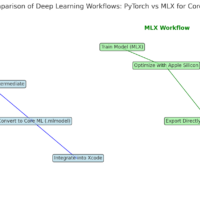A Detailed Comparison of Deep Learning Optimizers: NAdam, AdaMax, AdamW, and NAG Introduction Optimizers are fundamental to training deep learning models effectively. They update the model’s parameters during training to minimize the loss function. In this article, we’ll compare four popular optimizers: NAdam, AdaMax, AdamW, and NAG. We’ll also explore their compatibility across frameworks like TensorFlow, PyTorch, and MLX for Apple Silicon, ensuring you choose the best optimizer for your specific machine learning task. 1. NAdam (Nesterov-accelerated Adam) Overview: NAdam combines the benefits of Adam with Nesterov Accelerated Gradient (NAG). It predicts the future direction of the gradient by adding momentum to Adam’s update rule, resulting in faster and smoother convergence. Key Features: Momentum Component: Utilizes Nesterov momentum to make more informed updates, reducing overshooting and improving convergence speed. Learning Rate Adaptation: Adapts learning rates for each parameter. Convergence: Often faster and more responsive than Adam in practice. Use Cases: Best for RNNs and models that require dynamic momentum adjustment. Particularly effective in recurrent tasks. Framework Support: TensorFlow: Fully supported. PyTorch: Fully supported. MLX (Apple Silicon): Not natively supported. However, users can implement NAdam using TensorFlow or PyTorch, which are compatible with MLX. Implementation in TensorFlow: tf.keras.optimizers.Nadam(learning_rate=0.001) 2. AdaMax (Adam with Infinity Norm) Overview: AdaMax is a variant of the Adam optimizer, replacing the L2 norm with the infinity norm. This results in more stable updates in high-dimensional spaces, such as models with embeddings. Key Features: Handling Large Gradients: Controls gradient scaling using the infinity norm, making it more stable when handling large updates. Convergence: Provides more stable convergence in models dealing with large, sparse data (e.g., NLP or embeddings-heavy models). Use Cases: Ideal for models with high-dimensional inputs, such as text embeddings or NLP models. Framework Support: TensorFlow: Fully supported. PyTorch: Fully supported. MLX (Apple Silicon): Not natively supported. Users can create custom implementations via TensorFlow or PyTorch on MLX. Implementation in TensorFlow: tf.keras.optimizers.Adamax(learning_rate=0.002) 3. AdamW (Adam with Decoupled Weight Decay) Overview: AdamW decouples weight decay from the gradient-based updates. In traditional Adam, weight decay is integrated directly into the update rule, which can result in over-regularization. AdamW separates…
Thank you for reading this post, don't forget to subscribe!

